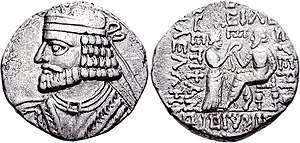Parthian coinage
Parthian coinage was produced within the domains of the Parthian Empire (247 BC – 224 AD). The coins struck by the Parthians were mainly made of silver,[3] with the main currencies being the drachm and tetradrachm.[4] The tetradrachm, which generally weighted around 16 g, was only minted in Seleucia, first conquered by the Parthians in 141 BC.[5] Design-wise, Parthian coinage was based on Seleucid and Achaemenid satrapal coinage.[6]

Tetradrachm of the Parthian king Vologases I, struck at Seleucia. On the reverse is a portrait of the king wearing a trouser-suit, diadem and beard. The observe depicts an investiture scene, where the king is receiving a scepter by the Greek goddess Tyche. In the Parthian era, Iranians used Hellenistic iconography to portray their divine figures,[1] thus the investiture scene can be associated with the Avestan khvarenah, i.e. kingly glory.[2]
See also
References
- Curtis 2012, pp. 76–77; Boyce 1984, p. 82
- Curtis 2012, p. 71; Olbrycht 2016, pp. 99
- Curtis 2007, pp. 9, 11–12, 16.
- Curtis 2007, pp. 7–25; Sellwood 1983, pp. 279–298
- Sellwood 1983, p. 282
- Rezakhani 2013, p. 767.
Sources
- Boyce, Mary (1984). Zoroastrians: Their Religious Beliefs and Practices. Psychology Press. pp. 1–252. ISBN 9780415239028.CS1 maint: ref=harv (link)
- Boyce, Mary; Grenet, Frantz (1991). Beck, Roger (ed.). A History of Zoroastrianism, Zoroastrianism under Macedonian and Roman Rule. Leiden: Brill. ISBN 978-9004293915.CS1 maint: ref=harv (link)
- Curtis, Vesta Sarkhosh; Stewart, Sarah, eds. (2007), The Age of the Parthians, Ideas of Iran, vol. 2, London: I. B. TaurisCS1 maint: ref=harv (link)
- Curtis, Vesta Sarkhosh (2007), "The Iranian Revival in the Parthian Period", in Curtis, Vesta Sarkhosh and Sarah Stewart (ed.), The Age of the Parthians: The Ideas of Iran, 2, London & New York: I.B. Tauris & Co Ltd., in association with the London Middle East Institute at SOAS and the British Museum, pp. 7–25, ISBN 978-1-84511-406-0
- Curtis, Vesta Sarkhosh (2012). "Parthian coins: Kingship and Divine Glory". The Parthian Empire and its Religions. pp. 67–83. ISBN 9783940598134.CS1 maint: ref=harv (link)
- Curtis, Vesta Sarkhosh (2019). "From Mithradat I (c. 171-138 BCE) to Mithradat II (c. 122/1-91 BCE): the Formation of Arsacid Parthian Iconography": 25–31. Cite journal requires
|journal=(help)CS1 maint: ref=harv (link)
- Olbrycht, Marek Jan (1997). "Parthian King's tiara - Numismatic evidence and some aspects of Arsacid political ideology". Notae Numismaticae. 2: 27–61.CS1 maint: ref=harv (link)

- Olbrycht, Marek Jan (2016). "The Sacral Kingship of the early Arsacids I. Fire Cult and Kingly Glory": 91–106. Cite journal requires
|journal=(help)CS1 maint: ref=harv (link) - Rezakhani, Khodadad (2013). "Arsacid, Elymaean, and Persid Coinage". In Potts, Daniel T. (ed.). The Oxford Handbook of Ancient Iran. Oxford University Press. ISBN 978-0199733309.CS1 maint: ref=harv (link)
- Sellwood, David (1983). "Parthian Coins". In Yarshater, Ehsan (ed.). The Cambridge History of Iran, Volume 3(1): The Seleucid, Parthian and Sasanian Periods. Cambridge: Cambridge University Press. pp. 279–298. ISBN 0-521-20092-X.
- Sinisi, Fabrizio (2012). "The Coinage of the Parthians". In Metcalf, William E. (ed.). The Oxford Handbook of Greek and Roman Coinage. Oxford University Press. ISBN 978-0195305746.CS1 maint: ref=harv (link)
| Wikimedia Commons has media related to Coins of Parthia. |
This article is issued from Wikipedia. The text is licensed under Creative Commons - Attribution - Sharealike. Additional terms may apply for the media files.